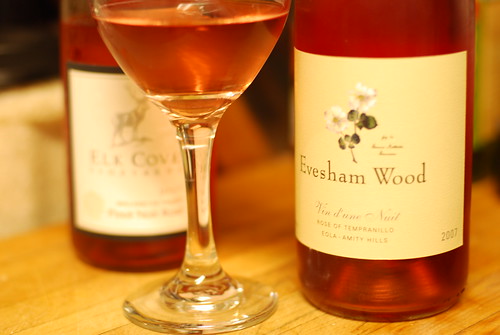
The wine manager at our local grocery store once reminded me, "And don't forget, your lovely-and-talented REALLY likes rosé."
She didn't have to remind me. Kim and I have both been fans of good, well-made rosé wines since June of 1994, at least. That was the anniversary that we flew her mom up to watch the girls, packed a picnic basket into the MGB, and took off to the Santa Cruz Mountains for our 15th anniversary.
The first night out, at the Davenport Inn a few miles north of Santa Cruz, we toasted the sunset with a bottle of Randal Grahm's then-unique "Vin Gris de Cigare," a pink wine made from Rhone varietals (grenache, syrah, cinsault, mourvedre). It was... dry, crisp, delicate, but tasted great chilled as we watched the sunset on the veranda outside our room.
The problem at that time was finding other wine-like rosés. Most pink wines, back then, were still of the "blush" variety, made by wineries trying to get back some of the return on their red grapes in a market dominated by white-wine drinkers. (As far as I'm concerned, wine is red; if it's white, it should have bubbles.)
Randal later introduced a Ca'del Solo rosé some time later; we once did a cross-tasting and came to the conclusion that while the Vin Gris de Cigare was a better wine, we enjoyed the Ca'del Solo more. It was a little fruitier but still not sweet; the vin gris was more austere, more (surprisingly) like a white wine, while the Ca'del Solo had more body, more fruit, and was also a better choice for serving with more highly flavored foods. Since we tend to match rosé with barbecue, a fuller-bodied wine is usually a better choice.
But apart from Bonny Doon and some French rosés (Provence and Anjou being fairly reliable), we were basically stuck.
Until recently.
Fortunately, our wonderful wine lady, Roberta, likes to talk with us and has been looking out for good, dry, fuller-bodied rosés with less residual sugar. Lately we tried two of our favorites, and better still, they're both local.
In between paragraphs, I'm sipping the last few milliliters of a 2007 Elk Cove rosé of pinot noir, from my neighbors in Gaston. (Gaston is at the western end of one of my favorite sports-car roads in the world, and a charming place to visit on its own.) It's got a lovely coppery color, a nice acid balance but a good amount of fruit (even to the point of being a little sweeter than I normally like, but not objectionably so). We're having it as a summertime refresher after dinner, a simple supper of our fresh, local bacon and a spinach salad. It would have been good with dinner, too, and in fact would be good with something spicy—a curry would be an awesome pairing with this wine.
And for all that... the Evesham Wood is one of the best wines I've tasted lately. And not just the best rosés, one of the best wines. It's got fabulous body, with all the usual tempranillo goodness of complexity, depth and richness, but in a lighter color suitable for chilling. I had a bottle recently, and was thrilled; sadly, I bought the last one in Roberta's stock, so I'll have to head down to Salem (about 30 miles from us) to the vineyard.
Because, considering that the tempranillo grape is originally from Spain, I want to make paella this summer and serve the Evesham Wood with it.


No comments:
Post a Comment